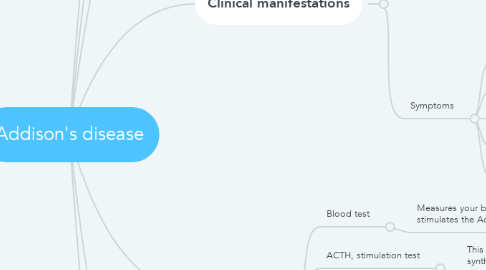
1. Definition
1.1. Addison's disease is a long-term endocrine disorder, affecting the adrenal glands. It results in decreased steroid hormone poduction and increased ACTH levels
1.1.1. Steroid hormones and ACTH
1.1.1.1. Functions: Metabolism Immune functions Inflamation Sexual characteristics, development Survival of stress Internal salt and water balance,..
1.1.1.2. Adenocorticotropic Hormone, ACTH: Assist the adrenal gland to produce corticosteroids.
1.1.2. Classification: by function:
1.1.2.1. Androgens (sex)
1.1.2.2. Adrenocortical (metabolism)
1.1.2.3. Anterior Pituitary Hormones (Grow, Metabolism, birth,..)
2. Chiropractic angle
2.1. What we can do?
2.1.1. As Chiro we can adjust them and keep them away from any other diseases.
2.1.2. Free restriction areas so that the body can function at its best.
2.2. What we can't do?
2.2.1. Hard structural adjustments around the adrenal gland must be avoid.
2.2.2. And also upper thoracic area, where sympathetic neurons are located.
3. Treatment
3.1. Hormone replacement therapy.
3.1.1. When Addison's patients are in Hormone therapy and avoid common triggers. Then they can live a long and healthy life.
3.1.1.1. To supplement glucocorticoid levels in the blood
3.1.1.1.1. 2-3x hydrocortisone a day
3.1.1.1.2. 10-15 mg/m2 may be administered
3.1.1.1.3. 1x fludrocortisone a day
3.1.1.1.4. 0.05-0.2mg may be administered, depending the patient
3.2. When in acute adrenal crisis
3.2.1. Fluid resuscitation of bodily fluids (to correct volume depletion)
3.2.2. Dextrose (to correct hypoglycaemia)
3.2.3. Hormone replacement (to correct a lack of circulating glucocorticoid)
4. Diagnosis
4.1. Blood test
4.1.1. Measures your blood levels of potassium, cortisol and adrenocorticotropic hormone (ACTH). Which stimulates the Adrenal Cortex to produce Hormones.
4.2. ACTH, stimulation test
4.2.1. This test measures the level of cortisol in your blood before and after an injection of synthetic ACTH.
4.3. Imaging tests
4.3.1. You may undergo some scans such as:
4.3.1.1. CT scan, to check the size of the Adrenal gland.
4.3.1.2. MRI, to check the pituitary gland for secondary adrenal insufficiency.
4.4. 21-hydroxylase autoantibodies
4.4.1. Test which will be used and ordered in hospitals when likely diagnosed with Addison's disease
5. Epidemiology data
5.1. 1 in 10000 people are affected with addison's disease throughout Europe
5.1.1. Female: male ratio is 1:8
5.1.2. Adults of all ages are affected
6. Clinical manifestations
6.1. One of the challenges with Addison's is the non-specifik nature of it's symptoms in the early stages. It is only in later stage that symptoms become clear.
6.2. Clinical signs
6.2.1. Increase in pigmentation
6.2.2. Weight loss
6.2.3. Hypotension
6.2.4. Anemia
6.2.5. Vitiligo and schock
6.3. Symptoms
6.3.1. Fatigue
6.3.2. Malaise
6.3.3. Appetite loss
6.3.4. Nausea
6.3.5. Dizziness
7. Aetiology
7.1. Any disease process which causes direct injury to the adrenal cortex can result in primary adrenal insufficiency. (Addison's disease)
7.1.1. Most cases are due to autoimmune response 70-90 procent.
7.1.1.1. Once 90 procent of adrenal cortex is damaged cortisol and aldosterone levels begin to fall below homeostatic levels, leads to symptoms addison's disease.
7.1.1.1.1. There is a link between autoimmune disease and certain genes namely vitiligo, type 1 diabetes and hypothyroidism which predispose a person to autoimmune conditions.
7.1.1.1.2. The most common cause of Addison's disease is Tuberculosis,Tb is a bacterial infection that effects the lung and Adrenal gland+cortex in multiple cases.
7.1.2. Other factors that could contribute to addison's.
7.1.2.1. Cancer
7.1.2.2. Surgerie of Adrenal cortex
7.1.2.3. Inflections damaging the Adrenal cortex
